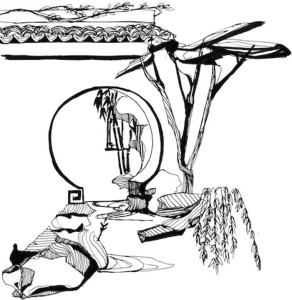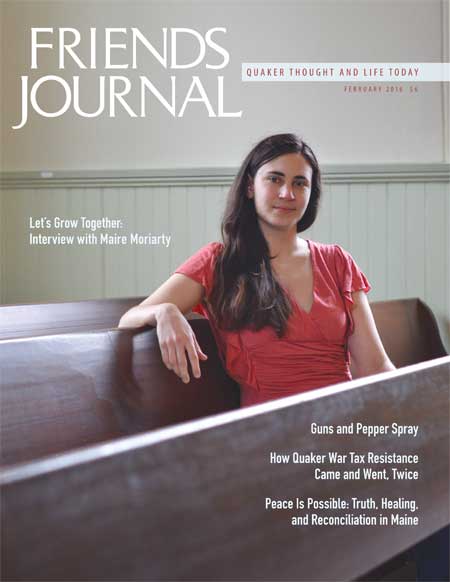
Quakers and Buddhists have a few things in common. Most importantly, they share a common humanity and a commitment to creating peace in the world. They are both enlightenment religions. Both George Fox and the Buddha experienced a transformative, liberating awareness through the dedicated practice of quiet contemplation.
My life is an intersection of these religions. I was born a Quaker, to Quaker parents with Quaker grandparents and great-grandparents. I attended Friends schools through college. I sat in many meetings for worship. I have always been proud to be a Quaker. I found Buddhism later in life, when I was 27 years old. I was looking for a tonic for depression. I found Buddhist philosophy and writing soothing to my condition. I liked that Buddhism talked about meditation as a remedy to suffering.
Even though I had been meditating all of my life in Quaker meetings, I had always struggled with how to do it. As a child, meeting for worship was somewhere between difficult and excruciatingly painful. To amuse myself, I would count things. I would count people with glasses. I would count ceiling tiles. I would count the seconds on my watch. I would welcome any spoken message that would break up the monotony of the silence. I would welcome the break of meeting so I could talk and run around again.
When I learned to meditate in the Buddhist style, I learned to keep my awareness focused by counting my breaths. I learned to hold my body still while I focused my mind. I found a specific place to put my hands. In meditation, I was relieved of the burden of being moved by the Spirit to speak and say something spiritually profound. Learning Buddhist meditation techniques taught me how to sit in Quaker meeting. Through all those years of Quaker upbringing and Quaker education, I had somehow missed that fundamental teaching.
In my Zen practice, I sat many hours of meditation. I did sitting meditation, walking meditation, chanting meditation, bowing meditation, eating meditation, tea-drinking meditation, and listening meditation. I went on a retreat to the Detroit Zen Center and did cooking meditation, cleaning meditation, weeding meditation, and hours and hours of sitting meditation. All that meditation was not necessarily peaceful or easy as I did it. What I found is that the rest of my days became more peaceful and easier to manage. The meditation worked. It created peace.
Besides the regular sitting practice, Zen is based on a philosophy that is different from Quakerism. Zen compelled me to practice with the enticement of an enlightenment experience. The Zen tradition is a long tradition, dating back to the Buddha (who is believed to have lived and taught between the sixth and fourth centuries B.C.E.), of purposefully awakening. Zen masters through the ages have skillfully worked with their disciples and students to create the conditions for awakening to the True Nature of reality. The push of a Zen practice is to recognize your own True Nature. The promise of that liberating experience was compelling enough to inspire me to do all that meditation.
As I studied Zen in Toronto, Ontario, I did not attend Quaker meeting. That changed when my family and I moved back to New Jersey in July 2013. Instead of finding an area Zen sangha (practice community), I returned to Quaker meeting for worship.
Upon returning to Quakerism, I found a group of earnest seekers, coming together in silence to try to find peace in their lives and create peace in the world. The meeting drew me into the community by inviting me to be on various committees. Committee work and the business of the meeting is one way that Quakers spread the peace of Sunday meeting for worship into the rest of the week.
In monthly meeting for business, making difficult decisions and resolving conflict test the peace of the worship. As a spiritual practice, recognizing the will of the group and releasing your own opinions can be transformative. It requires patience, respect, faith, and competent leaders to guide the process. When these factors are not present, the group may make decisions, but individuals feel excluded, egos grow, and conflict escalates. I’ve witnessed this in many meetings throughout my life. I’ve also witnessed excellent conflict resolution, where all participants feel committed to the direction of the group and uplifted through the resolution of conflict and a clear way forward.
Recognizing your True Nature in Zen and coming to a decision through Quaker process are both exercises in understanding our egos and, ultimately, easing our suffering by releasing them. This is a transformative experience that Quakerism and Buddhism offer.
In Zen, the awakening experience is a starting point for the rest of life, which will provide many more opportunities for further awakening experiences. In Quakerism, the awakening experience is not discussed. It happens to some, but it is not a goal of the practitioner. Creating peace and making the world a better place seems to be the driving goal for Quakers. Quakers practice kindness, respect, simplicity, integrity, honesty, community, generosity, gratitude, humility, listening, worship, joy, and compassion in pursuit of that goal. Like my Quaker upbringing did not teach me how to sit in meeting, Quakers don’t often discuss how these practices work to transform our lives and the lives of others.
What I believe Quakers can learn from Buddhism—or the secular form of Buddhism, mindfulness—is how awareness transforms our thoughts, our lives, and the world. As we are present with our kindness, compassion, simplicity, generosity, and gratitude, we are connected to the Spirit and our True Nature. When we are present with our anger, sadness, and fear, we are still connected. Maintaining presence and awareness is something that Quakers do well. Recognizing that these practices transform us and the world can help keep us focused on what we are doing and why we are doing it.
It is refreshing for me to sit in Quaker meeting for worship. With my Zen training, I sit like the original Quakers, with my back straight, not resting on the back of the bench. I find that position gives me more alertness. I listen to messages of love, gratitude, peace, and struggle, and I feel communion with the people assembled. I find world peace in meeting. The Soto school of Zen Buddhism maintains that sitting meditation is enlightenment. In Quakerism, sitting in meeting for worship is enlightenment. It can be helpful to know that.



Greetings Gail…
I’ve subscribed to the Friend YouTube channel for several months, and I just got around to listening to Peter’s discussion on Zen Buddhism and Quakerism. Please pass along my kudos to Peter for a very good presentation (I’ve been practicing Zen for about 15 years).
I recently discovered two that physicist that I very much admire Sir Arthur Stanley Eddington and George Ellis our Quakers (see below), so I was interested in finding out if a presently non-Quaker… would be allowed to submit an article for your oversight for inclusion in the Friends Journal.
If the answer is yes, I’d be interested in submitting an article on famous scientists within the Friend’s community if this topic has not already been covered. I do have a science background in the fields of Radiation Oncology (cancer treatment) and a Masters degree Information Systems from Friends University in Wichita Kansas.
Thanks Kindly
Donald Abdallah
[Email and phone redacted by moderator]
▪ Arthur Stanley Eddington — active in the Quaker Guild of Teachers, attended meetings regularly; his Swarthmore Lecture was titled “Science and the Unseen World.”
▪ George Ellis — co-authored The Large Scale Structure of Space-Time with University of Cambridge physicist Stephen Hawking; won the 2004 Templeton Prize and got involved with the Quaker Service Fund